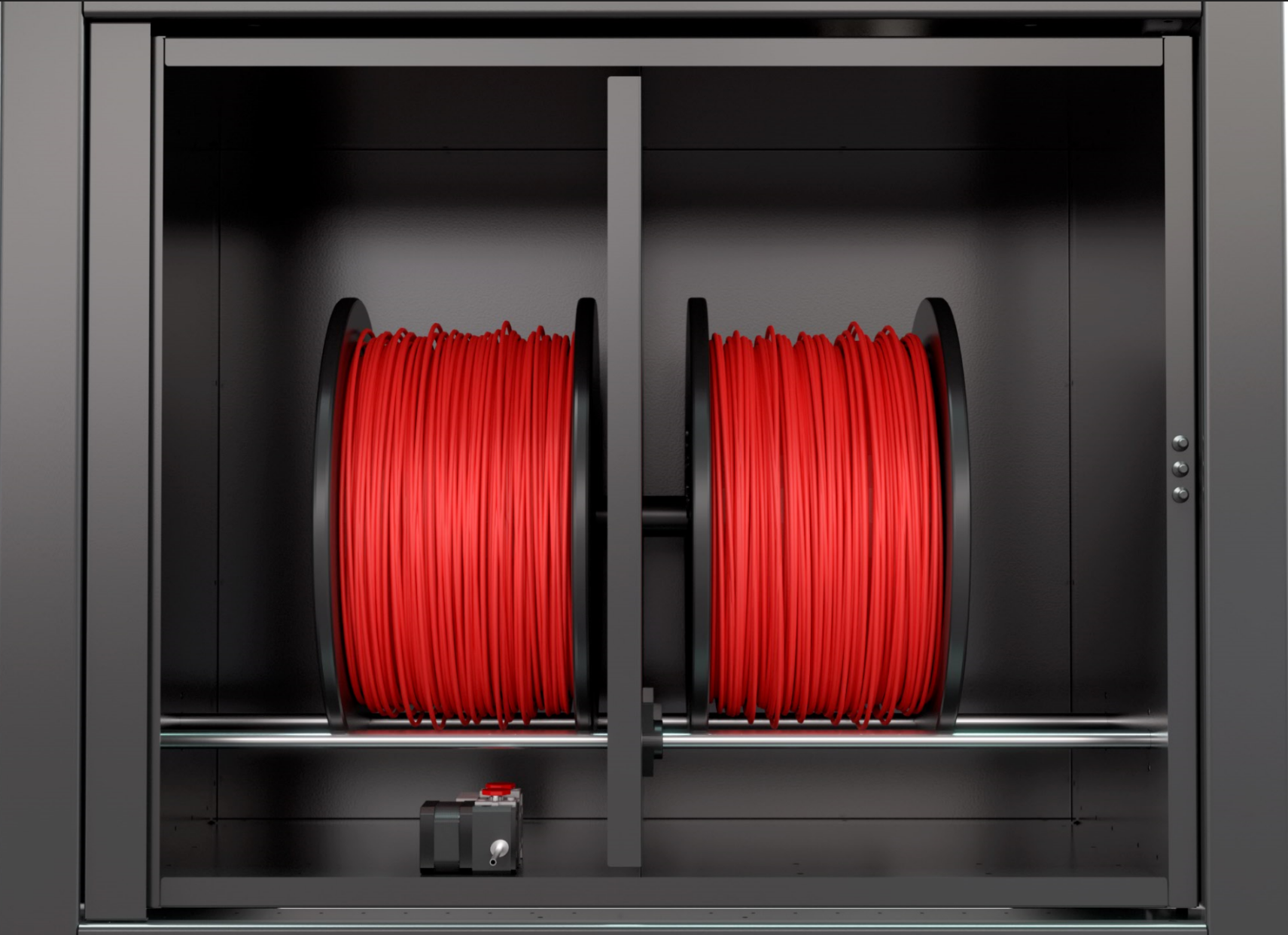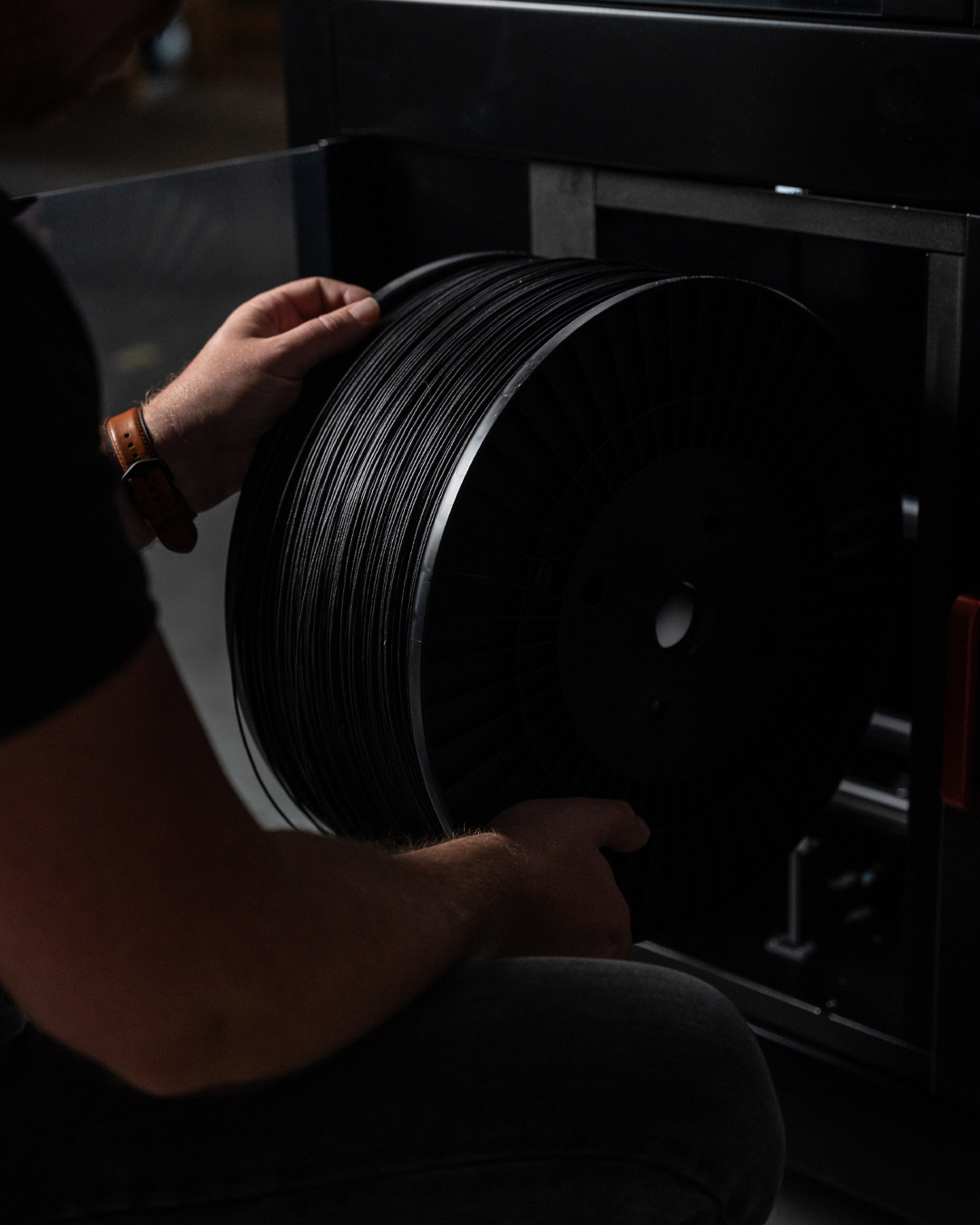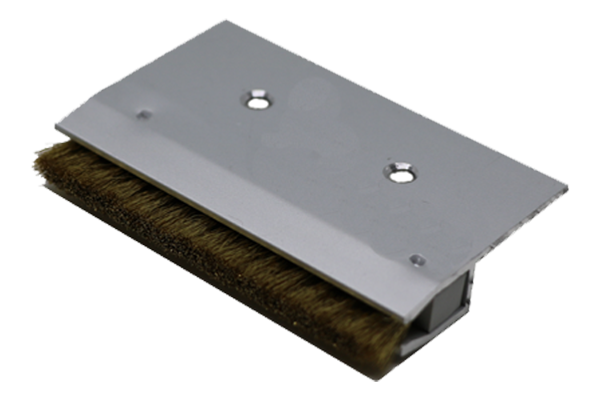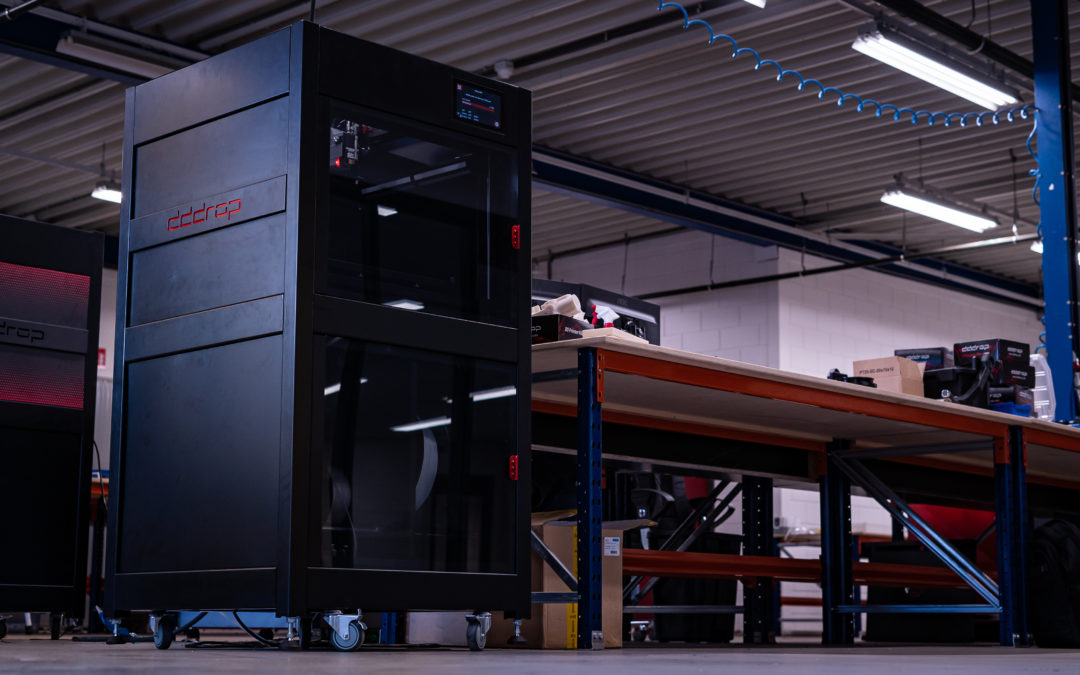
by admin | Feb 23, 2018 | Blog
Filling is an important factor
The infill is an important factor in your product’s strength. Therefore, it’s important to prevent the infill from being too thin or stringy with the tips underneath.
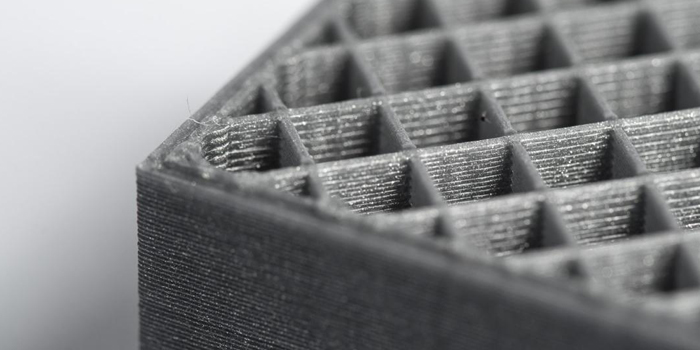
Different patterns:
There are several different infill patterns to choose from, and each leads to different degrees of strength. Examples of robust infills are lattice, triangular or solid honeycomb. Less robust are rectilinear and fast honeycomb infills. However, these less robust fills may still be preferred, as these types can be printed faster and are robust enough for most products.
Slower printing speed:
The infill is usually printed more slowly than other parts of the product. If the print speed is set too high, the nozzle cannot extrude enough material. Result: a thin and stringy infill that does not provide the proper strength. Therefore, try to lower the ‘Solid Infill Underspeed’ slightly so that the printer has enough time for a strong infill.
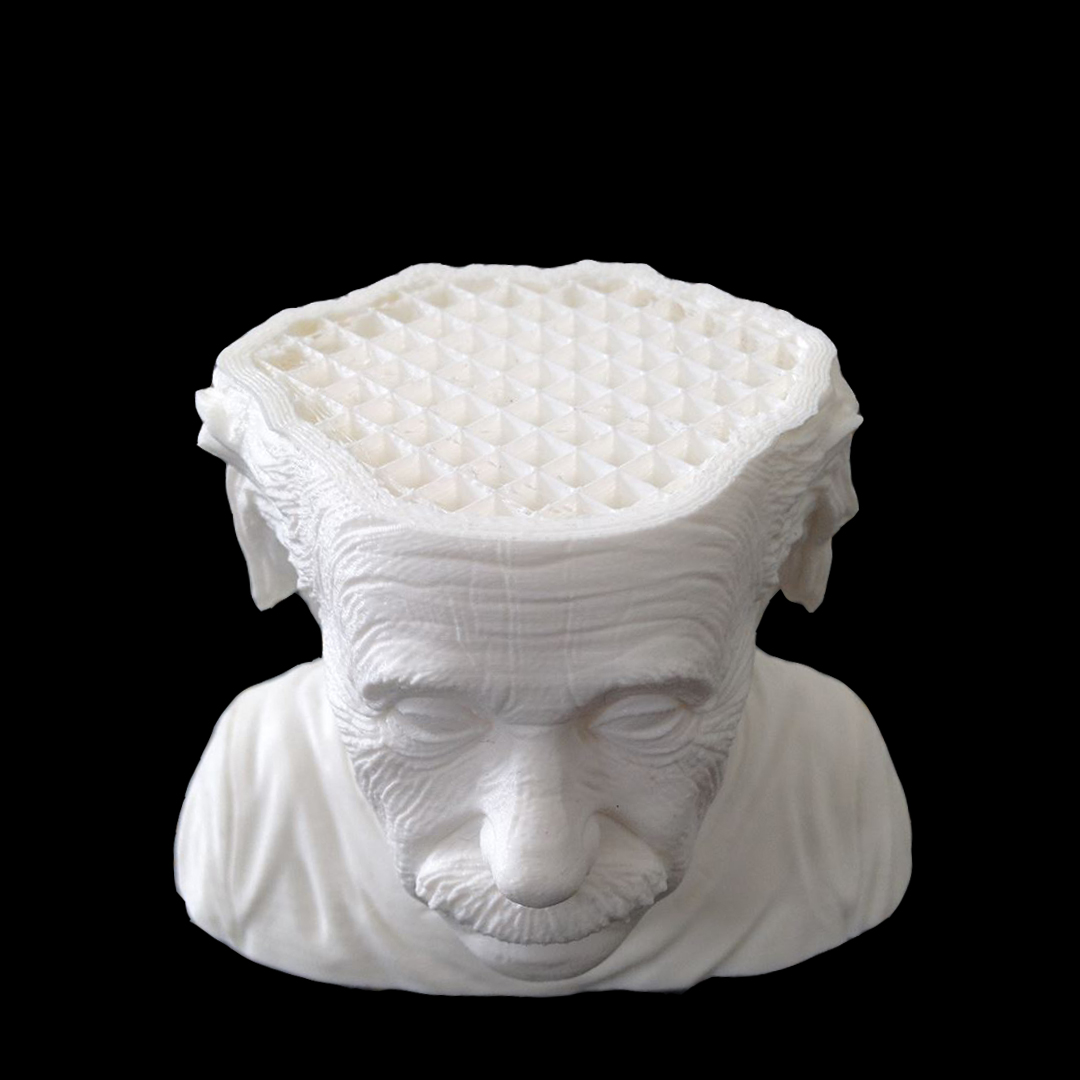 High infill extrusion:
High infill extrusion:
For all products, the thicker the infill, the stronger the product. You can make the infill thicker by increasing the width of the grid. Set the Infill Extrusion Width to 110% to extrude more material and get a firmer grid. However, making the infill thicker means that more material is required and the printing process is slowed down. Therefore, you can simultaneously loosen the infill by placing the grids further apart. To do this, adjust the infill percentage in the slicing software.
Conclusion:
You want to print fast and not waste too much material, but you also want to give your product the right strength. It’s therefore important to find the right balance! Experiment with different infill patterns, the printing speed and the infill extrusion to achieve the result that meets your product requirements.
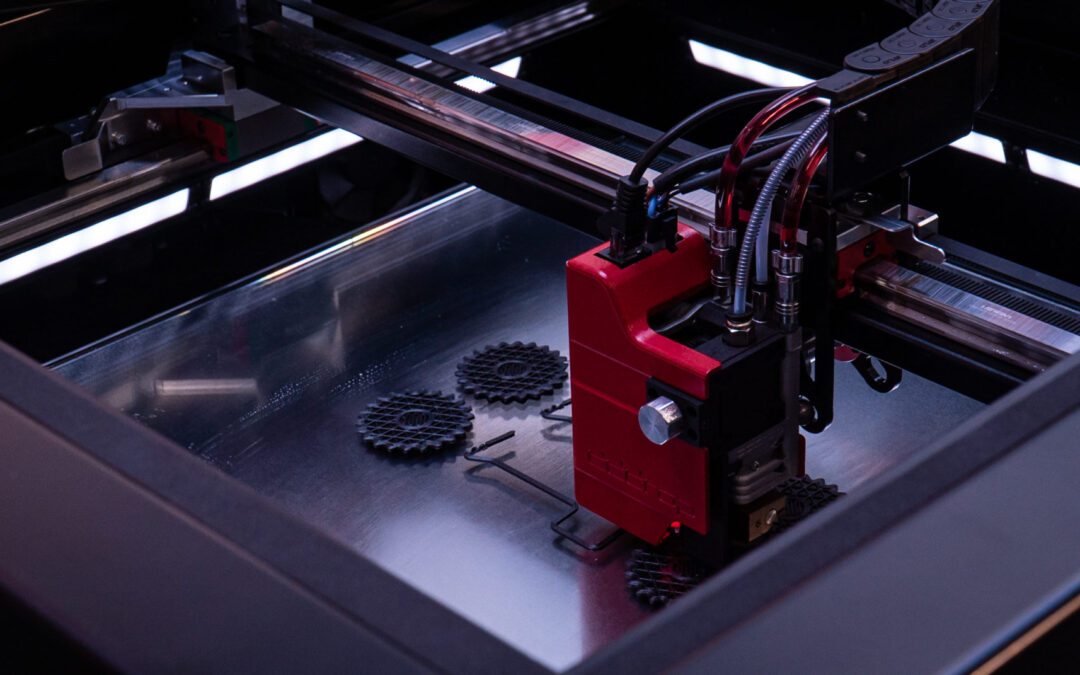
by admin | Dec 21, 2017 | Blog
Printing your new house in 3D
Building your own house is an exciting project: What will it look like? Will it turn out the way you imagined? Sander Teunissen was in the middle of such a construction project and dealt with the same questions until dddrop printed a 3D scale model of his house.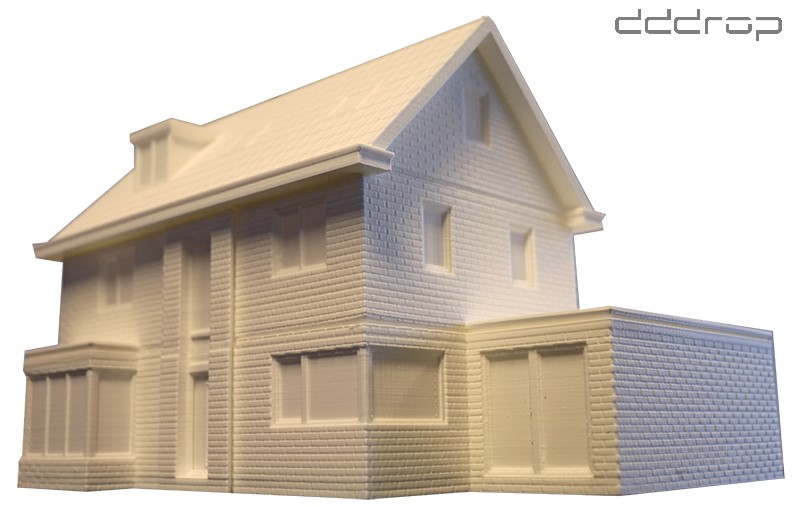

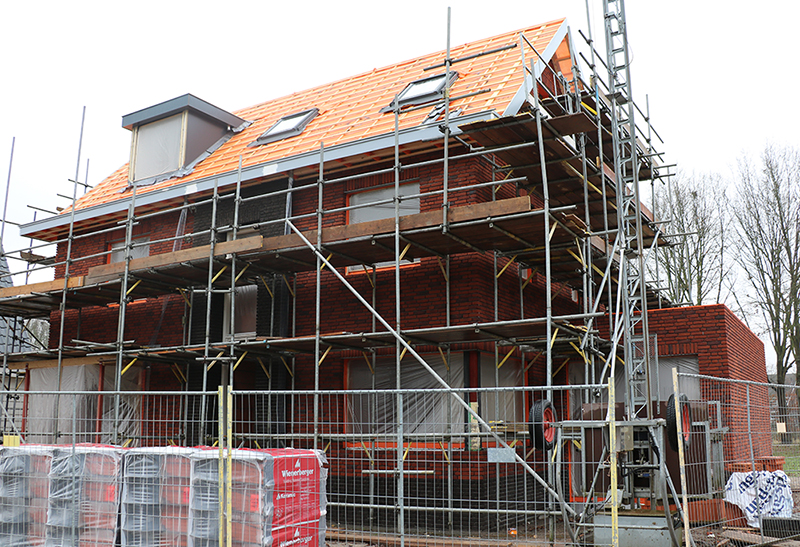
The design
When Sander and his wife bought the lot, they had the wish to design the house themselves, together with the architect. This way, they had the freedom to determine the layout and the angle of the light. Besides that, they decided to add solar panels and a heat pump. “You have no clue what you get yourself into,” Sander says. “ It takes a while before you can visualize the house, which makes it very exciting when the walls are finally being built.” To give Sander more insight into his future home, dddrop printed a 3D scale model based on the construction drawings. “It is a perfect replica and everything is in there, even the solar panels and roof tiles. The greatest thing is that you can disassemble every floor. This enables you to look inside the house and see the layout, even some furniture is there. It all comes to life with the scale model, we even made some small adjustments based on it,” Sander says delighted.
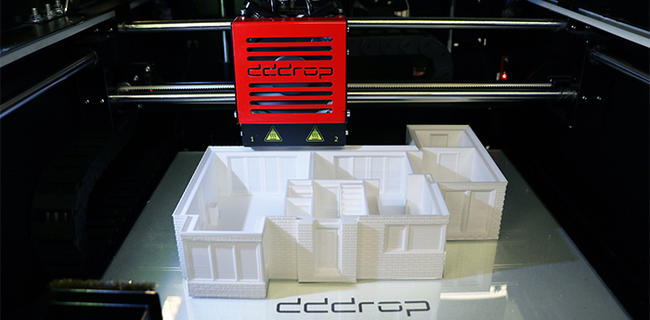
Eye catcher
Sander was not the only one who responded positively to the model. It also attracted the attention of others: “We’ve already had a few birthday parties and everyone responded absolutely thrilled. We also showed the model to our architect and contractor, they loved it as well of course!” Sander and his wife have two children and especially the eldest responded enthusiastic. Sander says: “The eldest is 5 and finds it very exciting that we are going to move. With the model, she has the ability to explain the layout and tell which room is going to be hers. The scale model is a success for the entire family and we gave it a prominent place in the house.”
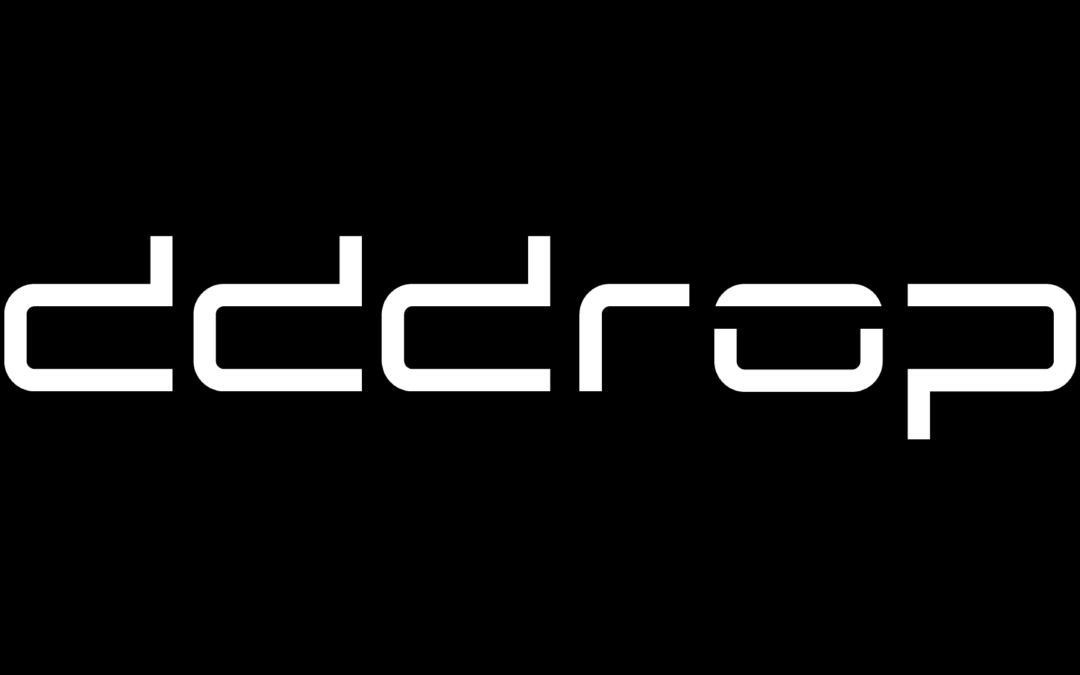
by admin | Dec 4, 2017 | Blog
Exhibition: Achterhoek in 3D!
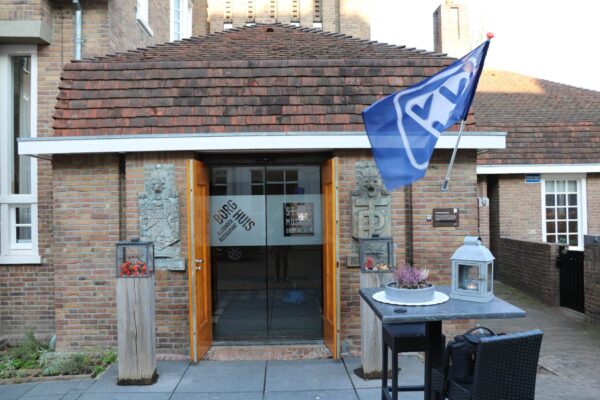 Almost a year ago, an enthusiastic group of volunteers started an ambitious project: printing the Achterhoek in 3D. After a public voting phase, nine landmarks were chosen for production. The 3D print group used SOLIDWORKS to draw the buildings, after which they were printed with a dddrop 3D printer. Meanwhile, the project is finished and the prints of the buildings are shown in the Stadsmuseum in Doetinchem.
Almost a year ago, an enthusiastic group of volunteers started an ambitious project: printing the Achterhoek in 3D. After a public voting phase, nine landmarks were chosen for production. The 3D print group used SOLIDWORKS to draw the buildings, after which they were printed with a dddrop 3D printer. Meanwhile, the project is finished and the prints of the buildings are shown in the Stadsmuseum in Doetinchem.
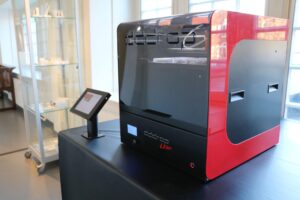 The process
The process
“We underestimated the drawing work” project employee Eefje Ernst says. “It was quite a lot of work, because the drawings need to be solid to print them properly. Because of this, the work got a bit delayed.” Luckily, the printing went successfully: “the process went through different phases. For example with the stone quarry of Winterswijk, we had difficulty creating real depth. We experimented until we had a beautiful stone quarry. About which print is Eefje the most satisfied? “I think about Ruimzicht, but that is purely because it contains a second layer. The balcony of Ruimzicht is placed separately, which creates more depth,” she says. It is great that you can print separate parts and later secure them on to each other. That makes it even more realistic.
The exhibition
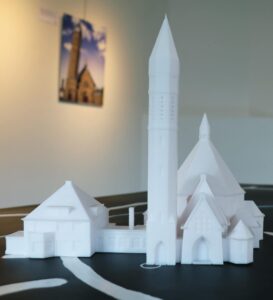 In the meantime, the buildings are finished and shown in the Stadsmuseum. The prints are placed on a big map of the region and photos of the original building are displayed. Besides that, a dddrop 3D printer is printing miniatures on site. There are also videos to be seen that explain the process. This makes the exhibition fun for everyone, young and old. Eefje: “The feedback is very positive. Visitors are enthusiastic about the set-up which gives the exposition
In the meantime, the buildings are finished and shown in the Stadsmuseum. The prints are placed on a big map of the region and photos of the original building are displayed. Besides that, a dddrop 3D printer is printing miniatures on site. There are also videos to be seen that explain the process. This makes the exhibition fun for everyone, young and old. Eefje: “The feedback is very positive. Visitors are enthusiastic about the set-up which gives the exposition
a body. The funny thing is that people picked up the buildings during the opening. I found that fascinating, because it is a museum after all. People just like to feel the buildings and see them from up close.
What’s next?
The exhibition is the last phase of the project: exhibiting the prints. Later on, the prints will be shown in the city centre, so that everyone can see them in a low threshold manner. “It is not clear how we will set this up yet,” Eefje explains. “But this is not the end of the project, the buildings will be shown outside.” Further on, the 3D print group will remain active. Every Tuesday evening, this group comes together and everyone is welcome to join. Eefje: “There is a possibility that other prints will be made for this project. Besides that, there is now time to print and experiment with other things again. Which the members of the group are very excited about!”
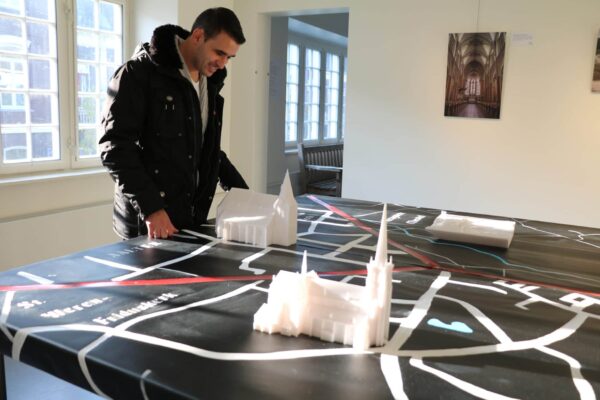

by admin | Nov 27, 2017 | Blog
3D Printing strong Carbon-fiber parts with dddrop 3D printers
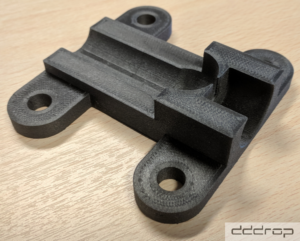 At the dddrop 3D printer laboratory the range of printing materials is expanding continuously. The PETG+Carbon material gives our users new possibilities printing high strength parts for applications that demand more than just plastics.
At the dddrop 3D printer laboratory the range of printing materials is expanding continuously. The PETG+Carbon material gives our users new possibilities printing high strength parts for applications that demand more than just plastics.
The Carbon fibers are really improving the, already quite tough, PETG material specs to new heights. The material is not only strong but also can endure rough (outside weather) conditions. 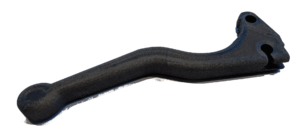
For example: It can be used to print custom clutch levers for top-level motorsports.
Just imagine what you can make, using a dddrop RAPID ONE and PETG + Carbon material!

by admin | Nov 24, 2017 | Blog
Printing metal parts
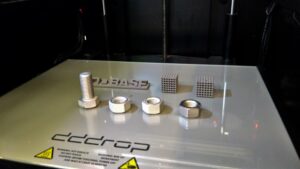
At dddrop we continue to develop. So we are also exploring the possibilities for metal printing. The dddrop EVO Twin allows you to print full Stainless Steel parts at very competitive prices. dddrop developed parts, like special nozzles, to durable print the metal parts. Parts are 3D printed with a special metal filament: BASF Ultrafuse 316LX. After the 3D printing stage, the de-binding and sintering process is almost equal to the MIM (Metal Injection Moulding) pocess. The end result is a true and high quality Stainless Steel 316L part.
Are you interested in metal printing? Please let us know, we would like to explain all possibilities:
Contact us

by admin | Aug 25, 2017 | Blog
3D printing is a remarkable technology that brings ideas to life, layer by layer, creating objects right before our eyes. However, like any technology, it comes with its challenges. One such challenge that many enthusiasts and professionals encounter is 3D printing clogging. This issue can halt production, leading to wasted time, resources, and, of course, the frustration of having to troubleshoot and fix the problem. In this guide, we delve into the common causes of 3D printing clogging, how to prevent it, and what to do if your printer nozzle becomes clogged. Join us on this journey to ensure a smoother 3D printing experience.
Common Causes of Clogging
Understanding what leads to 3D printing clogging is the first step towards finding a lasting solution. Here are some prevalent causes:
- Filament Quality: Low-quality or contaminated filament can introduce foreign particles into the nozzle, causing clogs.
- Nozzle Alignment: Misaligned nozzles can scrape against the print, accumulating material that eventually leads to clogging.
- Temperature Settings: Inadequate temperature settings can either cause the filament to burn and stick to the nozzle or not melt sufficiently to flow smoothly.
In the next section, we will explore preventive measures to keep your 3D printing operations running clog-free.
Preventing Clogs
Prevention is better than cure, especially in the realm of 3D printing. Here are some proactive steps to combat 3D printing clogging:
- Regular Maintenance: Regular cleaning and inspection of your nozzle will help catch potential issues before they escalate.
- Choose the Right Filament: Opt for high-quality, contaminant-free filaments that are suited for your printer’s specifications.
- Proper Settings: Ensure your printer’s temperature and speed settings are optimized for the material you are using to prevent overheating or underheating, which could lead to clogs.
Unclogging Your 3D Printer
At some point, you might encounter 3D printing clogging despite your preventive measures. When this occurs, it’s crucial to address the clog efficiently to resume your printing projects. Here’s a step-by-step guide to unclogging your 3D printer:
- Identify the Clog: Determine the extent and location of the clog.
- Heat the Nozzle: Warm up the nozzle to loosen the clogged material.
- Manual Cleaning: Use a cleaning filament or a fine needle to remove the clog gently.
- Cold Pull Technique: Employ the cold pull technique to eliminate any residue.
- Check and Realign: After unclogging, check the alignment and ensure that the filament path is clear before resuming printing.
By following these steps, you can resolve 3D printing clogging and get back to bringing your creations to life.
Understanding the Cold Pull Technique
The Cold Pull Technique is a proven method to clear away residue from your nozzle’s interior. Initially, heat the nozzle to a temperature suitable for your filament type, then cool it down slightly below its normal printing temperature. Insert the filament and allow it to cool further. Once cooled, pull the filament out with a swift, steady motion. The idea is that the filament adheres to any residue within the nozzle, and pulls it out when removed. This technique is highly effective in preventing and resolving 3D printing clogging, ensuring a clean nozzle for a smooth printing experience.
The Right Tools for the Job
Having the right tools at your disposal can significantly ease the process of maintaining a clog-free 3D printer. Here are some recommended tools and accessories:
- Cleaning Filaments: Special filaments designed to clean the nozzle from the inside.
- Nozzle Needles: Fine needles can help dislodge clogs from the nozzle.
- Nozzle Brushes: These can be used to clean the exterior of the nozzle.
- Quality Filament: Invest in high-quality filament to reduce the chances of 3D printing clogging.
- Temperature Gun: A handy tool to ensure your printer reaches the correct temperature.
Equipped with these tools, you’ll be better prepared to prevent and address clogging issues, promoting a seamless 3D printing experience.
Material-Specific Guidelines
Different materials have distinct characteristics that can affect how they flow through the nozzle, potentially leading to 3D printing clogging. Here are some guidelines:
- PLA: Ensure proper cooling as PLA can become sticky when overheated.
- ABS: Maintain a consistent high temperature to prevent the material from hardening and clogging the nozzle.
- PETG: Clean the nozzle regularly as PETG can leave residues that harden over time.
- TPU: Print at a slower speed to prevent this flexible material from jamming.
Adhering to material-specific guidelines can significantly reduce the likelihood of encountering clogs while working with various filaments.
Conclusion
Navigating through the realm of 3D printing comes with its fair share of challenges, with clogging being a notable one. However, with a keen understanding of common clogging causes, preventive measures, and effective unclogging techniques, you can significantly minimize downtime caused by 3D printing clogging. Equipped with the right tools and knowledge, you’re now ready to tackle any clogging issues head-on and enjoy a smoother, more productive 3D printing experience. Remember, regular maintenance and adherence to material-specific guidelines are your allies in maintaining a clog-free printing journey.
FAQ
Why does my 3D print keep clogging?
Your 3D print may keep clogging due to impurities in the filament, misalignment of the nozzle, or inadequate cleaning practices. These factors may obstruct the filament’s smooth passage, leading to consistent clogs.
What to do if your 3D printer is clogged?
If your 3D printer is clogged, disassemble and clean the nozzle thoroughly using a cleaning filament or solvent. You can also heat the nozzle to remove any residual filament.
How do I stop my nozzle from clogging?
To prevent your nozzle from clogging, ensure you use high-quality, clean filament and maintain proper alignment of the printer parts. Regular cleaning and periodic maintenance checks can also help in preventing clogs.
Why does my extruder keep clogging mid print?
Your extruder may clog mid-print due to temperature fluctuations, incorrect printer settings, or the use of incompatible filament material. It’s essential to monitor the printing process and adjust settings accordingly.
How often should you clean 3D printer nozzle?
It’s advisable to clean your 3D printer nozzle after every 10 hours of printing. However, the frequency may increase if you use materials prone to causing clogs or if you observe a decline in print quality.
Why is my 3D printer nozzle jamming?
Your 3D printer nozzle may jam due to incorrect temperature settings, a worn-out nozzle, or the use of improper filament material. Replacing or upgrading the nozzle and using the recommended filament and settings can alleviate jamming issues.


 High infill extrusion:
High infill extrusion:






 Almost a year ago, an enthusiastic group of volunteers started an ambitious project: printing the Achterhoek in 3D. After a public voting phase, nine landmarks were chosen for production. The 3D print group used SOLIDWORKS to draw the buildings, after which they were printed with a dddrop 3D printer. Meanwhile, the project is finished and the prints of the buildings are shown in the Stadsmuseum in Doetinchem.
Almost a year ago, an enthusiastic group of volunteers started an ambitious project: printing the Achterhoek in 3D. After a public voting phase, nine landmarks were chosen for production. The 3D print group used SOLIDWORKS to draw the buildings, after which they were printed with a dddrop 3D printer. Meanwhile, the project is finished and the prints of the buildings are shown in the Stadsmuseum in Doetinchem.
 The process
The process In the meantime, the buildings are finished and shown in the Stadsmuseum. The prints are placed on a big map of the region and photos of the original building are displayed. Besides that, a dddrop 3D printer is printing miniatures on site. There are also videos to be seen that explain the process. This makes the exhibition fun for everyone, young and old. Eefje: “The feedback is very positive. Visitors are enthusiastic about the set-up which gives the exposition
In the meantime, the buildings are finished and shown in the Stadsmuseum. The prints are placed on a big map of the region and photos of the original building are displayed. Besides that, a dddrop 3D printer is printing miniatures on site. There are also videos to be seen that explain the process. This makes the exhibition fun for everyone, young and old. Eefje: “The feedback is very positive. Visitors are enthusiastic about the set-up which gives the exposition
 At the dddrop 3D printer laboratory the range of printing materials is expanding continuously. The PETG+Carbon material gives our users new possibilities printing high strength parts for applications that demand more than just plastics.
At the dddrop 3D printer laboratory the range of printing materials is expanding continuously. The PETG+Carbon material gives our users new possibilities printing high strength parts for applications that demand more than just plastics.


